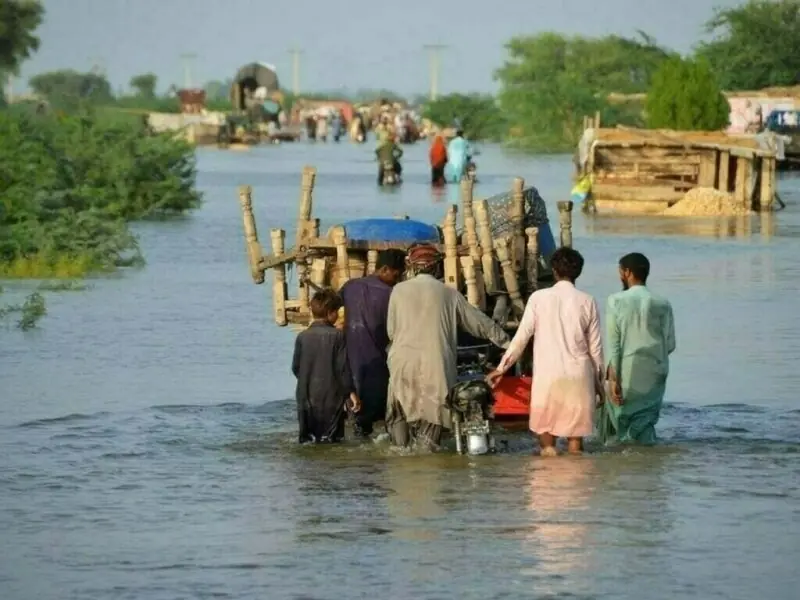By Mushtaq Gaadi
Copyright brecorder

In the past fifteen years, Pakistan has paid more for floods than many countries spend on schools, hospitals, and the dreams of their children.
In 2010, the waters took away lives and livelihoods worth $13 billion. In 2022, the swollen Indus and its tributaries pushed that figure to $18 billion. And in 2025, though no careful estimates are yet available, the damages have already exceeded $20 billion, for this time the waters drowned the heartlands — the Grand Trunk Road corridor — where houses, factories, bazaars, and mosques jostle shoulder to shoulder.
From Sindh to Punjab, from the Sutlej to the Chenab, the rivers are no longer free. They are caged giants, and caged giants do not sleep quietly.
In all, Pakistan has suffered over $50 billion in losses in a mere decade and a half. If this arithmetic continues, Pakistan will soon not be a country making budgets, but a country counting ruins.
But these are not just floods of the kind that ancient farmers knew, when the river rose, spilled over, and settled back into its course. These are embankment floods — a peculiar tragedy of modern South Asia. An embankment flood occurs when a river, held tightly between artificial levees or walls, bursts through its confinement. Unlike natural floods that once spread gently over floodplains, depositing silt and life, embankment floods unleash destruction with a violent surge, for the water has been bottled up, denied its natural room to breathe, and finally breaks free with fury.
In the pre-barrage era, the Indus, Chenab, and Sutlej meandered like giant snakes, shifting course, flooding lowlands, and nourishing fertile belts through seasonal inundation. But with colonial rule came a new hydrology: barrages, canals, and embankments. Rivers were enclosed, trained like circus animals to jump through hoops of British engineering. Postcolonial governments only strengthened this enclosure, adding more dams, more barrages, more embankments. Today, Pakistan has built a staggering 6,718 kilometers of embankments and 1,375 spurs along the Indus system. From Sindh to Punjab, from the Sutlej to the Chenab, the rivers are no longer free. They are caged giants, and caged giants do not sleep quietly.
Pakistan’s flood crisis: nature strikes, humans fail
This is not a lesson Pakistan alone is learning. Across the border in Bihar, India, Dinesh Kumar Mishra has written and spoken for decades about the paradox of embankments. In his telling, Bihar built over 3,500 kilometres of embankments to tame the Kosi and Ganga. Instead, floods worsened: rivers rose higher, silted up, and broke their chains more violently. Farmers were trapped between embankments, their villages submerged in stagnant pools of water with no drainage. The cure became the disease. Mishra called these embankments a “prison” for both rivers and people. And Pakistan, too, is fast building a similar prison along the Indus.
Pakistan must abandon the dream of irrigating high, thirsty lands of central Punjab against the grain of nature
Yet, South Asia has known gentler ways of living with water. Our forefathers listened to rivers rather than shackling them. In Sindh under the Talpurs, in Bahawalpur under the Abbasis, and in Multan under Sawan Mul, irrigation was built around the principle of natural drainage. Instead of pushing rivers up to the higher grounds of the central Punjab as done under British colonialism, they dug inundation canals that flowed along with the natural course of the Indus rivers. The fields drank what the river offered, and agriculture prospered. In riverine and dry belts, they turned to the underground aquifers, lifting water with Persian wheels. In foothill and flash flood regions, they devised the spate irrigation system (rod-kohi) to guide flash floods into farmlands. These were not systems of conquest, but of accommodation — technologies of humility, not hubris.
Today, with solar pumps, sensors, and satellite mapping, such systems can be reimagined for the 21st century. But for this, Pakistan must abandon the dream of irrigating high, thirsty lands of central Punjab against the grain of nature. Instead, Sindh and the Siraiki belt, naturally cradled within the Indus drainage basin, can once again become the heartlands of irrigation — if only rivers are allowed to flow as they must.
The rivers of South Asia are not enemies to be defeated. They are ancient companions, lifelines of culture and civilisation.
The tragedy is not just economic. Colonial hydrology — the barrages, the river training, the relentless embankments — was designed for revenue, not resilience. It was meant to convert rivers into obedient canals for cotton fields and wheat exports.
Today, its costs are economic, as the mounting flood losses now exceed entire national development budgets; political, as water quarrels between provinces and riparians sharpen old divides; and ecological, as dying wetlands, blocked drainage, and irreversible damage to the Indus basin continue to spread. And who pays the real cost? Not the engineers, builders, bureaucrats and international financiers who designed, invested and executed embankments. Not the policymakers who boast of new dams. It is the millions of marginalised families who live between and behind embankments, neither protected from the river nor free of its wrath. They rebuild huts every year, only to watch them drown again.
The rivers of South Asia are not enemies to be defeated. They are ancient companions, lifelines of culture and civilisation. To chain them is to invite disaster. To free them is to accept humility. As the proverb goes: “Don’t push the river, it will flow by itself.” Pakistan must learn this truth, before the rivers teach it again — in another season of embankment floods, another year of losses, another tally of grief.
118 died in floods, rain-related incidents in Punjab
This learning, however, is futile within Pakistan’s borders alone. The Indus basin is shared, and any new vision of water management demands transboundary cooperation between India and Pakistan. The principles of sharing enshrined in the Indus Waters Treaty need to be renegotiated in light of climate change and the mounting havoc of floods.
The current crisis surrounding the Treaty affords an opportunity to both Pakistan and India move beyond the rigidities of the past and embrace a spirit of new water diplomacy, where rivers are managed as shared lifelines rather than divided spoils.
The article does not necessarily reflect the opinion of Business Recorder or its owners



